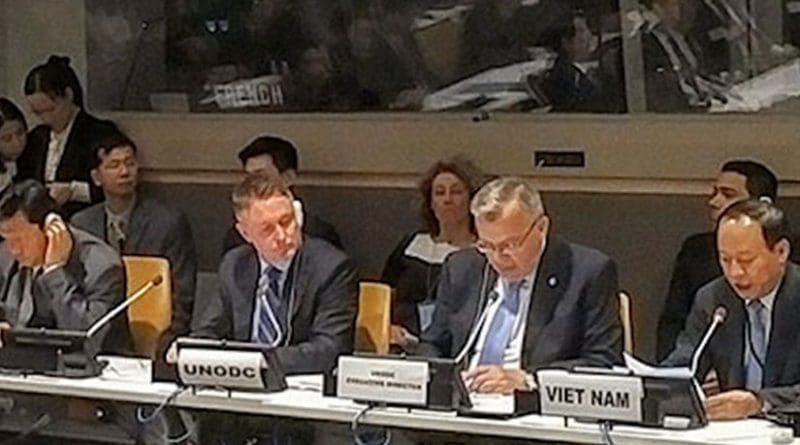Six Mekong Countries Reinforce Regional Drug Strategy – Analysis
By IDN
By Hanns Kuttner*
The Mekong Memorandum of Understanding (MOU) on Drug Control, a framework that incorporates law enforcement, criminal justice, alternative development, and health responses in six countries in East and Southeast Asia continues to be of critical importance more than twenty-five years after it was signed.
Despite significant efforts, the six MOU countries – Cambodia, China, Lao PDR, Myanmar, Thailand and Viet Nam – that constitute the Greater Mekong Sub-region continue to face challenges in stemming the flow of illicit drugs and precursor chemicals in, to and from the area.
After a decade of steady declines, the illicit cultivation of opium poppy has increased each year since 2006. Today, cultivation is concentrated in Myanmar and Lao PDR. Synthetic drugs, particularly methamphetamine in pill and crystal forms, have emerged as the primary drug threat in the Sub-region. The diversion and subsequent trafficking of precursors chemicals, and the emergence of new psychoactive substances, also continue to impact the area.
This emerged from a high-level briefing on April 19 by Mekong countries and the Vienna-based UN Office on Drugs and Crime (UNODC) on the margins of the UN General Assembly Special Session on the world drug problem (UNGASS) that informed the international community on the current drug situation in the region incorporating the well-known Golden Triangle.
Initially established in 1995 to cover a period of three years, the MOU was changed in 1997 to a rolling plan of action with no time limit, to be periodically revised and updated in order to better address newly emerging drug control priorities.
The Mekong MOU is meanwhile recognized as an effective framework for achieving some degree of success in combating the transnational threat of illicit drugs.
Its future was discussed during the UNGASS (April 19-21) at a high-level “private meeting” between UNODC Executive Director Yury Fedotov; Le Quy Vuong, Deputy Minister of Public Security, Viet Nam; Guo Shengkun, Minister of Public Security, China; Myint Htwe, Minister of Health, Myanmar; Paiboon Koomchaya, Minister of Justice, Thailand; Kou Chansina, Chairman of Lao National Commission for Drug Control; and Ry Tuy, Permanent Representative of Cambodia to the United Nations.
“The Mekong MOU’s comprehensive vision for drug control cooperation provides an important practical contribution to the debate on the need for a balanced approach,” said Fedotov. “Inputs by the six MOU countries define the shared future direction to address the regional drug challenge, ultimately benefitting the international community as well,” he said.
The varied types and sheer volume of illicit drugs being trafficked highlights in the Mekong the scale of the problem being faced. “The Mekong is a distinctive drug market, with multifaceted challenges that require multifaceted solutions”, said Jeremy Douglas, UNODC’s Regional Representative for Southeast Asia and the Pacific.
“It is encouraging to engage policy makers as they reflect on how well past plans have worked, considering data and formulating responses,” Douglas added, according to the UN Information Service (UNIS) in Vienna.
Significantly, the Mekong MOU promotes a balanced approach to addressing drug threats – utilizing a programmatic strategy that encompasses several thematic areas: law enforcement cooperation; legal and judicial cooperation; sustainable alternative development; and drugs, health and HIV.
The mechanism has also started a review process to ensure MOU partners and UNODC identify challenges as they arise. This allows the countries to adapt and respond to the changing dynamics of the regional drug market, and is an integral element of the Mekong MOU going forward, UNIS said.
“The evolution of the Mekong MOU into an effective multilateral framework for cooperation and collaboration is underpinned by an understanding of the need for solutions with nuanced geographical considerations,” said Douglas. “This includes recognition that effective solutions need to go beyond transnational law enforcement initiatives and incorporate judicial, development and health considerations.”
“We are working to improve responses,” said Tun Nay Soe, head of drug analysis and programming at UNODC’s Regional Office for Southeast Asia and the Pacific. “But importantly, these improvements have consistently and increasingly incorporated community and individual health considerations, and stem from the viewpoint that enforcement alone has not yielded the desired results.”
According to UNODC, the Sub-regional Action Plan (SAP) is the engine that drives the MOU process. It provides a strategic outline for collaborative efforts of MOU signatories and puts into place action-oriented programmes that assist member Governments, individually and collectively, to fight illicit drug production, trafficking and abuse.
The SAP covers five thematic areas: Law Enforcement Cooperation; International Cooperation on Legal and Judicial Matters; Drug Demand Reduction; Drugs and HIV; and Sustainable Alternative Development.
These five thematic areas above contain individual Workplans that outline and implement these activities and initiatives. Ultimately, these activities build the legal, institutional and operational capacities of member Governments.
The SAP is primarily implemented through clearly defined activities and initiatives that address specific problems and operational weaknesses, says UNODC.

